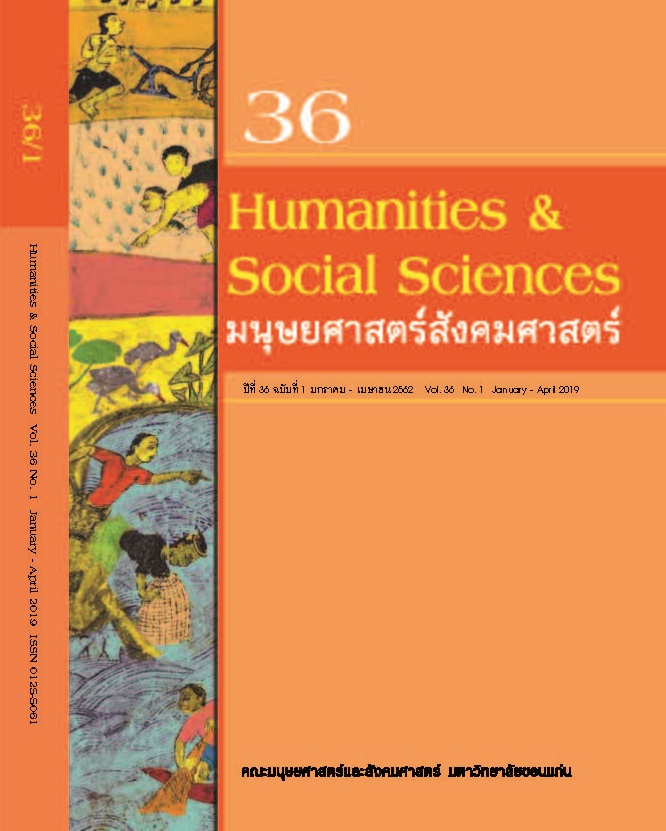[สิว คือ ข้าศึกศัตรู] : อุปลักษณ์เชิงมโนทัศน์ของผู้ใช้ภาษาในห้องสนทนาเกี่ยวกับความงามบนเว็บไซต์พันทิปดอทคอม /ACNE IS ENEMY : Conceptual Metaphor of Language User in Chat room About Beauty on Pantip Website
Keywords:
Metaphorical Expressions, Conceptual Metaphor, Function of Metaphor, Acne, EnemyAbstract
The objectives of this article were to analyze metaphorical expressions and functions interpreting through conceptual metaphor of Thai language users comparing ACNE IS ENEMY. This article adopted metaphorical framework in term of cognitive linguistics perspective by Lakoff and Johnson,1980 and function of metaphor by Goatly ,1998 according to pragmatics framework. Metaphorical expressions were specifically collected from Toh Khreuang Paeng chat room of Pantip website since 2014-2017 where people went for exchanging, commenting and posting about health and beauty issues. The mentioned source is the medium of language rhetoric which is clearly capable of revealing language use phenomena especially metaphor.
The results found 55 metaphorical expressions of enemy semantic filed. They reflected acne is enemy, attacking, hurting human disfigured and causing human unhealthy both on their physical and mind. Although acne is a general disease which is closely related to human, it was an abstract concept and difficult to understand. Thus, comparison could be employed to describe about acne concepts linking some enemy experiences such as war, fighting and effects of enemy. Those concepts perceived from our daily life and they were taken to interpret about acne concepts for instance, acne is horrible and dangerous person, so it must be completely eliminated. Likewise the interpretation of acne is Enemy revealed that the comparison of salience features in enemy concepts were interpreted being acne clearer. Due to the acne and the enemy were both the damage and caused any trouble for human.
The results of function of metaphor comparing Acne is Enemy had 2 functions ; 1) ideational function including explanation and modeling as well as reconceptualization 2) textual function including textual structuring which is aimed to build the consistency of details and help to enhance memorability, foregrounding, and in formativeness.
References
สาขาวิชาภาษาศาสตร์ บัณฑิตวิทยาลัย จุฬาลงกรณ์มหาวิทยาลัย.
. (2544). การใช้ภาษาใน "ห้องสนทนา". วารสารศิลปศาสตร์, 1(1), 77-92.
. (2548). อุปลักษณ์ตามแนวคิดของทฤษฎีภาษาศาสตร์ปริชาน. วารสารศิลปศาสตร์, 5(1), 1-16.
เชิดชัย อุดมพันธ์. (2555). อุปลักษณ์เกี่ยวกับโรคในภาษาไทยถิ่นใต้. วิทยานิพนธ์ปริญญาปรัชญาดุษฎีบัณฑิต
สาขาวิชาภาษาไทย บัณฑิตวิทยาลัย มหาวิทยาลัยสงขลานครินทร์.
ณัฐพร พานโพธิ์ทอง. (2556). วาทกรรมวิเคราะห์เชิงวิพากษ์ตามแนวภาษาศาสตร์. กรุงเทพฯ:
โครงการเผยแพร่ผลงานวิชาการ คณะอักษรศาสตร์ จุฬาลงกรณ์มหาวิทยาลัย.
ธนพล เอกพจน์. (2560). “ความจน คือ โรค”:อุปลักษณ์เชิงมโนทัศน์ของผู้ใช้ภาษาไทยที่สะท้อนผ่านการใช้
ภาษาบนเว็บไซต์พันทิปดอทคอม. วารสารมนุษยศาสตร์ ฉบับบัณฑิตศึกษา, 6(1), 93-109.
. (2561). อุปลักษณ์เชิงมโนทัศน์ความจนในภาษาไทย: กรณีศึกษาการใช้ภาษาไทยบนเว็บไซต์
พันทิปดอทคอม. วารสารรมยสาร, 16(1), 377-400.
ธนพล เอกพจน์และวิรัช วงศ์ภินันท์วัฒนา. (2560). “ความทุกข์ คือ โรค” : อุปลักษณ์มโนทัศน์ที่สะท้อนผ่าน
รูปคำอุปลักษณ์ ในภาษาไทย. KKU International Journal of Humanities and Social Sciences, 7(2), 38-58.
ธัญพิมล เทพไกรวัลและทินวัฒน์ สร้อยกุดเรือ. (2561). ลักษณะภาษาในการตั้งชื่อเฟซบุกของนักเรียนชั้น
มัธยมศึกษาตอนปลายในจังหวัดขอนแกน. KKU International Journal of Humanities and Social Sciences, 8(1), 186-208.
นววรรณ พันธุเมธา. (2555). คลังคำ. พิมพ์ครั้งที่ 6. กรุงเทพฯ: อมรินทร์.
นิวัติ พลนิกร. (2527). สิว. นิตยสารหมอชาวบ้าน, 10.
นพรัตน์ น้อยเจริญและสิริวรรณ นันทจันทูล. (2561). “แม่คือนักบริหาร” ถ้อยคำอุปลักษณ์ที่สะท้อนจากผู้ใช้
ภาษาในนิตยสารเกี่ยวกับแม่และเด็ก. วารสารมหาวิทยาลัยศิลปากร, 38(1), 65-85.
ปิยภรณ์ อบแพทย์. (2552). อุปลักษณ์เกี่ยวกับชีวิตในหนังสือธรรมะ. วิทยานิพนธ์ปริญญาอักษร
ศาสตรมหาบัณฑิต สาขาวิชาภาษาไทย บัณฑิตวิทยาลัย จุฬาลงกรณ์มหาวิทยาลัย.
ยมลภัทร ภัทรคุปต์. (2553). อุปลักษณ์ความตายในหนังสือธรรมะ. วิทยานิพนธ์ปริญญา
อักษรศาสตรมหาบัณฑิต สาขาวิชาภาษาไทย บัณฑิตวิทยาลัย จุฬาลงกรณ์มหาวิทยาลัย.
รัชนีย์ญา กลิ่นน้ำหอม. (2556). อุปลักษณ์ความสุขในบล็อกไทย. วารสารสถาบันวัฒนธรรมและศิลปะ,
14(2), 132-138.
รัชนีย์ญา กลิ่นน้ำหอม และพฤทธิ์ ศุภเศรษฐศิริ. (2560). น้ำท่วมคือสงครามและประชาชนคือเหยื่อ :
มโนทัศน์ที่สะท้อนจากพาดหัวข่าวในหนังสือพิมพ์ไทย. วารสารสถาบันวัฒนธรรมและศิลปะ,
19(37), 114-125.
ราชบัณฑิตยสถาน. (2556). พจนานุกรมฉบับราชบัณฑิตยสถาน พ.ศ. 2554. พิมพ์ครั้งที่ 2. กรุงเทพฯ :
ราชบัณฑิตยสถาน.
วิกิพีเดีย. (2561). พันทิป.คอม. สืบค้นเมื่อ 10 พฤศจิกายน 2561, จาก https://th.wikipedia.org/wiki/
พันทิป.คอม.
วิลาวัณย์ วิษณุเวคิน. (2550). อุปลักษณ์ในหนังสือเรียนวิทยาศาสตร์ไทย. วิทยานิพนธ์ปริญญา
อักษรศาสตมหาบัณฑิต สาขาวิชาภาษาไทย บัณฑิตวิทยาลัย จุฬาลงกรณ์มหาวิทยาลัย.
วุฒินันท์ แก้วจันทร์เกตุ. (2555). กิเลส: การศึกษาอุปลักษณ์เชิงมโนทัศน์ในภาษาไทย. วารสารมนุษยศาสตร์,
19(2), 24-41.
วรวรรณา เพ็ชรกิจ. (2551). การศึกษาอุปลักษณ์เกี่ยวกับโรคมะเร็งในภาษาไทยตามแนวปริชานศาสตร์
และวัจนปฏิบัติศาสตร์. วิทยานิพนธ์ปริญญาอักษรศาสตดุษฎีบัณฑิต สาขาวิชาภาษาศาสตร์
บัณฑิตวิทยาลัย จุฬาลงกรณ์มหาวิทยาลัย.
ศิริพร ปัญญาเมธีกุล. (2548). ภาษาในห้องสนทนาทางอินเทอร์เน็ต. วารสารมนุษยศาสตร์ปริทรรศน์, 27,
63-71.
ศุภชัย ต๊ะวิชัย. (2549). อุปลักษณ์เชิงมโนทัศน์แสดงอารมณ์โกรธในภาษาไทย. วิทยานิพนธ์ปริญญา
อักษรศาสตรมหาบัณฑิต สาขาวิชาภาษาไทย บัณฑิตวิทยาลัย มหาวิทยาลัยศิลปากร.
. (2556, มกราคม-เมษายน). มโนทัศน์พื้นที่ในภาษาไทย: กรณีศึกษาคำว่า ‘หลัง’ ที่ปรากฏใน
เว็บไซต์พันทิปดอทคอม. วารสารมนุษยศาสตร์และสังคมศาสตร์, 6(1), 131-148.
สุรเชษฐ์ พิชิตพงศ์เผ่า. (2553). อุปลักษณ์ชีวิตในหนังสือแนะนำการดำเนินชีวิต: การศึกษาความสัมพันธ์
ระหว่างภาษากับมโนทัศน์. วิทยานิพนธ์ปริญญาอักษรศาสตรมหาบัณฑิต สาขาวิชาภาษาไทย
บัณฑิตวิทยาลัย จุฬาลงกรณ์มหาวิทยาลัย.
สถาบันโรคผิวหนัง กรมการแพทย์ กระทรวงสาธารณสุข. (2561). สิว (Acnes). สืบค้นเมื่อ 12 พฤศจิกายน
2561, จาก https://inderm.go.th/news/view.php?id_view=616.
อุมาวัลย์ ชาติไอยรานนท์. (2561). [คอมมิวนิสต์ คือ ศัตรู] : อุปลักษณ์เชิงวิพากษ์ในวาทกรรมของ
หลวงวิจิตรวาทการ. ในการประชุมหาดใหญ่วิชาการระดับชาติและนานาชาติ ครั้งที่9. 20
กรกฎาคม 2561. มหาวิทยาลัยหาดใหญ่. (หน้า 165-178)
เอกพล ดวงศรี. (2561). กรรม : อุปลักษณ์เชิงมโนทัศน์ที่สะท้อนความเชื่อในสังคมไทย. วารสารวิจัย
และพัฒนา มหาวิทยาลัยราชภัฏสวนสุนันทา, 10(1), 86-102.
Siyuan, Z รัชนีย์ญา กลิ่นน้ำหอม และมนตรี เจียมจรุงยงศ์. (2556). “ชีวิตคืออะไร”: มโนทัศน์ชีวิตในเว็บ
บล็อกของไทยและจีน. วารสารวจนะ, 1(2), 43-60.
ภาษาอังกฤษ
Beger, A.; & Flensburg, J. (2009). ANGER, LOVE and SADNESS revisited: differences
In metaphors between experts and laypersons in the genre Psychology guide. Retrieved November 10, 2018, from
https://www.metaphorik.del/sites/www.metaphorik.de/journal-pdf/16_2009_begerjaekelpdf.
Goatly, A. (1998). The Language of Metaphors. London : Routledge.
Nicholls, A. (2004). What we talk about when we talk about illness. Retrieved November
10, 2018, from https://www.macmillandictionaries.com/MED-Magazine/January2004/15-metaphor-illness-print.htm.
Kövecses, Z. (2010). Metaphor: A Practical Introduction. 2nd ed. Oxford: Oxford University Press.
Lakoff, G. and Johnson, M. (1980). Metaphor we live by. Chicago and London: University of
Chicago Press.



